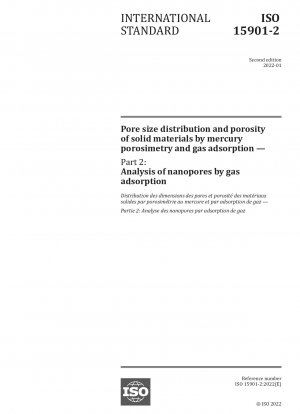ISO 15901-2:2022
Pore size distribution and porosity of solid materials by mercury porosimetry and gas adsorption — Part 2: Analysis of nanopores by gas adsorption
- Standard No.
- ISO 15901-2:2022
- Release Date
- 2022
- Published By
- International Organization for Standardization (ISO)
- Latest
- ISO 15901-2:2022
- Scope
- This document describes a method for the evaluation of porosity and pore size distribution by physical adsorption (or physisorption). The method is limited to the determination of the quantity of a gas adsorbed per unit mass of sample as a function of pressure at a controlled, constant temperature[1]-[9]. Commonly used adsorptive gases for physical adsorption characterization include nitrogen, argon, krypton at the temperatures of liquid nitrogen and argon (77 K and 87 K respectively) as well as CO2 (at 273 K). Traditionally, nitrogen and argon adsorption at 77 K and 87 K, respectively, allows one to assess pores in the approximate range of widths 0,45 nm to 50 nm, although improvements in temperature control and pressure measurement allow larger pore widths to be evaluated. CO2 adsorption at 273 K – 293 K can be applied for the microporous carbon materials exhibiting ultramicropores. Krypton adsorption at 77 K and 87 K is used to determine the surface area or porosity of materials with small surface area or for the analysis of thin porous films. The method described is suitable for a wide range of porous materials. This document focuses on the determination of pore size distribution from as low as 0,4 nm up to approximately 100 nm. The determination of surface area is described in ISO 9277. The procedures which have been devised for the determination of the amount of gas adsorbed may be divided into two groups: — those which depend on the measurement of the amount of gas removed from the gas phase, i.e. manometric (volumetric) methods; — those which involve the measurement of the uptake of the gas by the adsorbent (i.e. direct determination of increase in mass by gravimetric methods). In practice, static or dynamic techniques can be used to determine the amount of gas adsorbed. However, the static manometric method is generally considered the most suitable technique for undertaking physisorption measurements with nitrogen, argon and krypton at cryogenic temperatures (i.e. 77 K and 87 K, the boiling temperature of nitrogen and argon, respectively) with the goal of obtaining pore volume and pore size information. This document focuses only on the application of the manometric method.
ISO 15901-2:2022 Referenced Document
- ISO 14488 Particulate materials — Sampling and sample splitting for the determination of particulate properties — Amendment 1
- ISO 3165 Sampling of chemical products for industrial use; Safety in sampling
- ISO 8213 Chemical products for industrial use; Sampling techniques; Solid chemical products in the form of particles varying from powders to coarse lumps
- ISO 9277 Determination of the specific surface area of solids by gas adsorption — BET method*, 2022-11-08 Update
ISO 15901-2:2022 history
- 2022 ISO 15901-2:2022 Pore size distribution and porosity of solid materials by mercury porosimetry and gas adsorption — Part 2: Analysis of nanopores by gas adsorption
- 2007 ISO 15901-2:2006/cor 1:2007 Pore size distribution and porosity of solid materials by mercury porosimetry and gas adsorption - Part 2: Analysis of mesopores and macropores by gas adsorption; Technical Corrigendum 1
- 2006 ISO 15901-2:2006 Pore size distribution and porosity of solid materials by mercury porosimetry and gas adsorption - Part 2: Analysis of mesopores and macropores by gas adsorption
